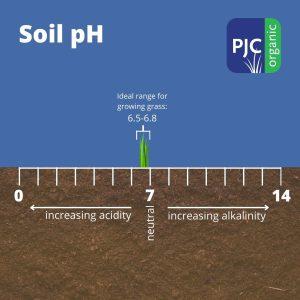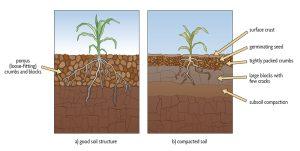What is Soil Compaction? In UMASS Extension’s Monthly E-Newsletter, Jason Lanier—UMASS Extension Turf Specialist—addresses the topic of soil compaction. He responds to the question: “I hear the term soil compaction a lot with regard to plant care and soil health. What exactly is soil compaction and why is it detrimental to plants?”
Lanier’s Response
The entirety of Jason Lanier’s response is included below in italics. Following his answer, we include PJC’s comments.
The solid fraction of soil has two principal ingredients: mineral fragments and organic material. What is important and valuable about soil is not only what is there, but also what isn’t there… in terms of the empty voids, the pore spaces.
These pore spaces are:
- how water infiltrates, and is held within, and drains from the soil.
- how beneficial gasses (like oxygen) reach plant roots, and how detrimental gasses escape.
- where plant roots grow.
Although this is a textbook example and almost never realistic, the perfect soil for the growth of most plants would be somewhere along the lines of 50% pore space… so essentially half empty space. The other 50%, the solid fraction, would be approximately 45% mineral material and about 5% organic matter.
What compaction involves are compressive forces, such as foot or vehicle traffic, that essentially collapse and crush this precious soil pore space, thereby making it smaller. “Heavier” soils with higher clay content and/or higher organic matter content compress much more readily and are therefore more prone to compaction. “Lighter”, sandier soils are more compaction resistant. Soil compacts more easily when it is wet (water lubricates soil particles and causes them to move and shift more readily), and less so when it is dry.
Compaction is measured in terms of bulk density… the amount of solid material per unit volume. A higher bulk density means more solid material per unit volume, which translates to less pore space and higher compaction severity. These measurements can be made with the right field equipment or with the help of a soil testing lab. Often, compaction can be diagnosed imprecisely, using cues such as pooling of water due to poor drainage, thinning of groundcovers such as turfgrasses, or prevalence of compaction tolerant weeds such as path rush (Juncus tenuis).
Greater compaction means fewer resources for roots (the foundation of the plant system), which are doubly compromised by having less physical real estate in which to grow. This means greater overall stress, more plant energy and resources required to combat these challenges, reduced plant performance, and higher maintenance demands. A big takeaway for compaction is that it is a chronic condition, meaning that it has the potential to increase gradually over time in response to repeated compression events. Once soil is significantly compacted, it is very difficult to remedy without major and disruptive intervention.
The best compaction solution is prevention. Soil is most vulnerable when it is “open”, or bare, so prevention should start immediately at the time of construction or plant establishment. This might involve steps like minimizing heavy equipment use, removing and stockpiling topsoil during sitework, conducting necessary screening or mixing activities off-site, and not working the soil when it is wet. In established landscapes and gardens, management includes minimizing traffic stress (especially when soil is wet, such as in early spring); eliminating exposed soil by way of grasses, groundcovers, or mulches; varying patterns when traffic can’t be avoided (such as varying mowing patterns on lawns) and/or restricting traffic to dedicated paths; and use of proper cultivation practices when and where appropriate.
Jason Lanier, UMass Extension Turf Specialist, UMASS Hort Notes 2023 Vol. 34:4 June 1, 2023 – Q&A.
PJC COMMENT — Sean’s Take
Another great article produced from Jason, this time regarding soil compaction. PJC’s Healthy Turf Circle captures the importance of healthy soils and how they, in turn, produce healthy turf. Jason characterizes 50% of the soil fraction being 45% mineral material and 5% organic matter.
Soil Chemistry—pH
 First, when addressing soil chemistry, we focus on the pH of the soil. Raising pH (decreasing active acidity) through liming is critical for several reasons, but we’ll focus on mineral make-up. Lime, “Calcium carbonate”, mechanistically raises pH. It does so by attaching the carbonate portion of the mineral to hydrogen ions and ‘flushes’ them out of the rhizosphere.
First, when addressing soil chemistry, we focus on the pH of the soil. Raising pH (decreasing active acidity) through liming is critical for several reasons, but we’ll focus on mineral make-up. Lime, “Calcium carbonate”, mechanistically raises pH. It does so by attaching the carbonate portion of the mineral to hydrogen ions and ‘flushes’ them out of the rhizosphere.
The primary function of raising pH for turf grass growth is to make macronutrients and micronutrients more abundantly available to turf roots. All essential plant nutrients are more available between pH of 6 and 7. Accordingly, the ideal pH rage for turf growth is between 6.5 and 6.7. The secondary function of liming is to increase available Ca2+ ions for turf utilization and soil structure. Calcium is a macronutrient by itself and facilitates movement of other nutrient compounds into the turf plant. I’d personally argue that lime is as important as fertilizer in a well-rounded turf program.
Soil Structure—Organic Matter
When addressing soil structure, we can look at two things: organic matter (OM) and cation exchange capacity. Organic matter holds water and nutrients. Accordingly, PJC considers a soil structure that is 5-15% OM to be ideal. In addition, OM is the primary food source for soil microbes. Soil microbes are critical to the mobility of nutrients in the soil from unavailable forms to available forms. PJC ProHealthy Turf Charge-S3 provides granular formed biochar and sugars to soil microbes to stimulate their activity in the soil.
Soil Structure—Cation Exchange Capacity

Source: “Building Soils for Better Crops”, sare.org
When evaluating cation exchange capacity—particularly through the lens of base saturation—we get a look at the mineral composition of the soil and further reduce that to Calcium to Magnesium ratios (Ca:Mg). The ratio of these two mineral elements is critical because calcium provides a stronger bond for soil particles, which allows them to preserve better pore space. Furthermore, pore space provides: the real estate for turf roots to grow, the area for water infiltration, and the area for healthy exchange of gasses in the soil.
To address calcium to magnesium ratios, we often recommend Gypsum, “Calcium Sulfate”, due to its track record in improving soil structure by increasing available Ca2+ ions for soil pore strength. Mechanistically, the sulfate portion of gypsum attaches to Magnesium ions and flushes them deeper into the soil profile. These Magnesium cations are replaced with Calcium cations which provide a more stable pore ‘wall’. Thus, stable pore space reduces the chance of compaction, increases water infiltration and encourages deeper rooting.
Diagnosing Compaction
To address Cultural Practices, let’s examine the “imprecise” diagnoses. Pooling water is an obvious sign of compaction. Unsurprisingly, if water can’t break the surface then the roots won’t receive the essential water molecule and can often rot at the crown. Thin turf – can be coupled with pooling water and overuse which are both key indicators of compaction. Lastly, the formation of weeds that like compacted soils. Dandelions and plantain favor compacted soil and are easy to identify. These weeds have strong roots, which essentially create their own poor space and assimilate calcium that is unavailable to the turf plant. Unavailable calcium = high compaction.
Cultural Practices to Address Compaction
There are two key ways to address compaction culturally: aeration and irrigation. Core aeration is the best method to physically remove the soil and create pore space. Ideally, over-seed and apply soil conditioners to help modify the structure of the soil as cores reincorporate. Secondly, implement appropriate watering schedules promote infiltration and reduce the chance of surface compaction.
Read our blogs “Summer Watering” and “Aerate, Over Seed and Feed Your Soil” for further cultural practice recommendations.
PJC COMMENT — Fred’s Take
All of the above is great stuff! I would like to just add a couple of simple comments…
How do I know if the soil is compacted? In most instances, merely walking on a lawn or athletic field you can assess if the soil is compacted. If it feels like you’re walking on a hard floor…it’s compacted.
How can I test for compaction? If simply walking on the turf is not enough, and you have a couple hundred dollars burning a hole in your pocket, you could go out and purchase a penetrometer. A penetrometer is a tool designed to mimic a plant root. It has a gauge that indicates pressure in pounds per square inch. The shaft will generally have graduations every 3 inches to help determine the depth of compaction. As noted above, pore space is where roots grow. In hard soils, with little to no pore space, narrow roots may be able to penetrate. But they are unlikely to contribute to vigorous plant growth.
Since I rarely have a couple hundred dollars in my pocket, I use an 8” flat head screwdriver that I have marked at 1 ½” and 3” that I will press in the soil to get a read on compaction.
How can I relieve compaction? As mentioned above changing soil chemistry goes a long way to relieving compaction. Encouraging bio-activity in the soil (microorganisms – fungi and bacteria, and earthworms). Also compaction may be relieved through mechanical means, though it may be short-lived.








